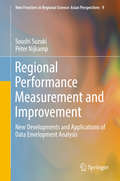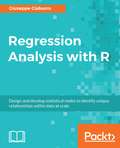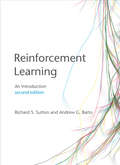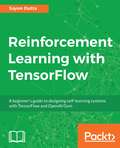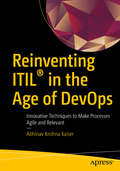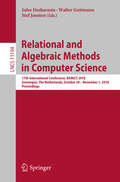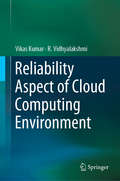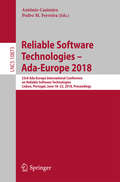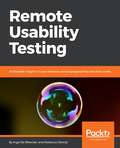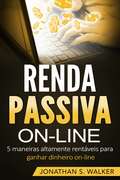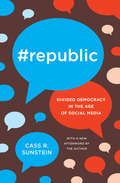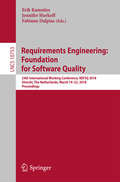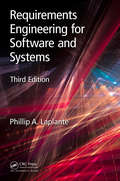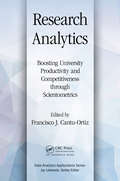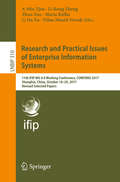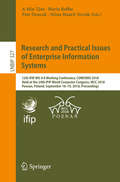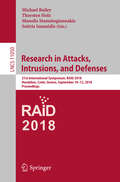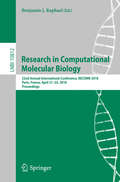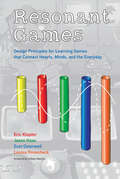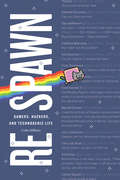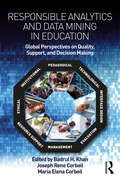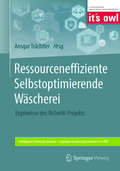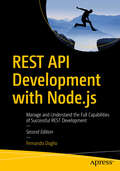- Table View
- List View
Regional Performance Measurement and Improvement
by Soushi Suzuki Peter NijkampThis is the first book to fully introduce a newly developed distance friction minimization (DFM) model, which is one of the new efficiency improvement projection approaches in data envelopment analysis (DEA). The DFM model can produce a most effective solution in efficiency improvement projections for inefficient spatial entities (decision-making units). The book provides a set of fresh contributions to a quantitative assessment of the performance of such policy entities. First it offers a state-of-the art overview of current DEA models and approaches, followed by the operational design of various new types of DEA models, each of them addressing weaknesses in traditional DEA approaches. Then it illustrates the assessment potential of DEA -- and its new variants, in particular, the DFM model and subsequent extensions -- on the basis of a broadly composed collection of empirical case studies, centering mainly but not exclusively on Japan and other Asian nations. gement, and related fields. New model applications offer a meaningful contribution to decision making and planning for operational efficiency improvement in these fields.
Regression Analysis with R: Design and develop statistical nodes to identify unique relationships within data at scale
by Giuseppe CiaburroBuild effective regression models in R to extract valuable insights from real data Key Features Implement different regression analysis techniques to solve common problems in data science - from data exploration to dealing with missing values From Simple Linear Regression to Logistic Regression - this book covers all regression techniques and their implementation in R A complete guide to building effective regression models in R and interpreting results from them to make valuable predictions Book Description Regression analysis is a statistical process which enables prediction of relationships between variables. The predictions are based on the casual effect of one variable upon another. Regression techniques for modeling and analyzing are employed on large set of data in order to reveal hidden relationship among the variables. This book will give you a rundown explaining what regression analysis is, explaining you the process from scratch. The first few chapters give an understanding of what the different types of learning are – supervised and unsupervised, how these learnings differ from each other. We then move to covering the supervised learning in details covering the various aspects of regression analysis. The outline of chapters are arranged in a way that gives a feel of all the steps covered in a data science process – loading the training dataset, handling missing values, EDA on the dataset, transformations and feature engineering, model building, assessing the model fitting and performance, and finally making predictions on unseen datasets. Each chapter starts with explaining the theoretical concepts and once the reader gets comfortable with the theory, we move to the practical examples to support the understanding. The practical examples are illustrated using R code including the different packages in R such as R Stats, Caret and so on. Each chapter is a mix of theory and practical examples. By the end of this book you will know all the concepts and pain-points related to regression analysis, and you will be able to implement your learning in your projects. What you will learn 1. Get started with the journey of data science using Simple linear regression 2. Deal with interaction, collinearity and other problems using multiple linear regression 3. Understand diagnostics and what to do if the assumptions fail with proper analysis 4. Load your dataset, treat missing values, and plot relationships with exploratory data analysis 5. Develop a perfect model keeping overfitting, under-fitting, and cross-validation into consideration 6. Deal with classification problems by applying Logistic regression 7. Explore other regression techniques – Decision trees, Bagging, and Boosting techniques 8. Learn by getting it all in action with the help of a real world case study.Who this book is for This book is intended for budding data scientists and data analysts who want to implement regression analysis techniques using R. If you are interested in statistics, data science, machine learning and wants to get an easy introduction to the topic, then this book is what you need! Basic understanding of statistics and math will help you to get the most out of the book. Some programming experience with R will also be helpful
Reinforcement Learning, second edition: An Introduction (Adaptive Computation and Machine Learning series #173)
by Richard S. Sutton Andrew G. BartoThe significantly expanded and updated new edition of a widely used text on reinforcement learning, one of the most active research areas in artificial intelligence.Reinforcement learning, one of the most active research areas in artificial intelligence, is a computational approach to learning whereby an agent tries to maximize the total amount of reward it receives while interacting with a complex, uncertain environment. In Reinforcement Learning, Richard Sutton and Andrew Barto provide a clear and simple account of the field's key ideas and algorithms. This second edition has been significantly expanded and updated, presenting new topics and updating coverage of other topics.Like the first edition, this second edition focuses on core online learning algorithms, with the more mathematical material set off in shaded boxes. Part I covers as much of reinforcement learning as possible without going beyond the tabular case for which exact solutions can be found. Many algorithms presented in this part are new to the second edition, including UCB, Expected Sarsa, and Double Learning. Part II extends these ideas to function approximation, with new sections on such topics as artificial neural networks and the Fourier basis, and offers expanded treatment of off-policy learning and policy-gradient methods. Part III has new chapters on reinforcement learning's relationships to psychology and neuroscience, as well as an updated case-studies chapter including AlphaGo and AlphaGo Zero, Atari game playing, and IBM Watson's wagering strategy. The final chapter discusses the future societal impacts of reinforcement learning.
Reinforcement Learning with TensorFlow: A beginner's guide to designing self-learning systems with TensorFlow and OpenAI Gym
by Sayon DuttaLeverage the power of the Reinforcement Learning techniques to develop self-learning systems using TensorflowKey Features Learn reinforcement learning concepts and their implementation using TensorFlow Discover different problem-solving methods for Reinforcement Learning Apply reinforcement learning for autonomous driving cars, robobrokers, and moreBook DescriptionReinforcement Learning (RL), allows you to develop smart, quick and self-learning systems in your business surroundings. It is an effective method to train your learning agents and solve a variety of problems in Artificial Intelligence—from games, self-driving cars and robots to enterprise applications that range from datacenter energy saving (cooling data centers) to smart warehousing solutions.The book covers the major advancements and successes achieved in deep reinforcement learning by synergizing deep neural network architectures with reinforcement learning. The book also introduces readers to the concept of Reinforcement Learning, its advantages and why it’s gaining so much popularity. The book also discusses on MDPs, Monte Carlo tree searches, dynamic programming such as policy and value iteration, temporal difference learning such as Q-learning and SARSA. You will use TensorFlow and OpenAI Gym to build simple neural network models that learn from their own actions. You will also see how reinforcement learning algorithms play a role in games, image processing and NLP.By the end of this book, you will have a firm understanding of what reinforcement learning is and how to put your knowledge to practical use by leveraging the power of TensorFlow and OpenAI Gym.What you will learn Implement state-of-the-art Reinforcement Learning algorithms from the basics Discover various techniques of Reinforcement Learning such as MDP, Q Learning and more Learn the applications of Reinforcement Learning in advertisement, image processing, and NLP Teach a Reinforcement Learning model to play a game using TensorFlow and the OpenAI gym Understand how Reinforcement Learning Applications are used in roboticsWho this book is forIf you want to get started with reinforcement learning using TensorFlow in the most practical way, this book will be a useful resource. The book assumes prior knowledge of machine learning and neural network programming concepts, as well as some understanding of the TensorFlow framework. No previous experience with Reinforcement Learning is required.
Reinventing ITIL® in the Age of DevOps: Innovative Techniques To Make Processes Agile And Relevant
by Abhinav Krishna KaiserDelve into the principles of ITIL® and DevOps and examine the similarities and differences. This book re-engineers the ITIL framework to work in DevOps projects without changing its meaning and its original objectives, making it fit for purpose for use in DevOps projects. Reinventing ITIL® in the Age of DevOpsshows you the relevance of ITIL since the emergence of DevOps and puts a unique spin on the ITIL service management framework. Along the way you will see that ITIL is a mature service management framework and years of maturity will be lost if it’s made invalid. The ideas, recommendations, and solutions provided in Reinventing ITIL in the Age of DevOps can be leveraged in order to readily develop solutions or create proposals for clients. The ideas in this book can be further expanded to deliver seamless services to DevOps projects. What You Will LearnDiscover the basics of ITIL and DevOpsCompare ITIL and DevOpsUnderstand the structure of a DevOps organization and adapt the ITIL roles to this structureRe-engineer ITIL for DevOps projectsImplement major processes such as incident management, configuration management, and change management processes in DevOps projectsAutomate activities within processesWho This Book Is For Consultants, business analysts, administrators, and project managers who are looking for more information about Dynamics 365.
Relational and Algebraic Methods in Computer Science: 17th International Conference, RAMiCS 2018, Groningen, The Netherlands, October 29 – November 1, 2018, Proceedings (Lecture Notes in Computer Science #11194)
by Jules Desharnais Walter Guttmann Stef JoostenThis book constitutes the proceedings of the 17th International Conference on Relational and Algebraic Methods in Computer Science, RAMiCS 2018, held in Groningen, The Netherlands, in October/November 2018. The 21 full papers and 1 invited paper presented together with 2 invited abstracts and 1 abstract of a tutorial were carefully selected from 31 submissions. The papers are organized in the following topics: Theoretical foundations; reasoning about computations and programs; and applications and tools.
Release It!: Design and Deploy Production-Ready Software
by Michael T. NygardA single dramatic software failure can cost a company millions of dollars - but can be avoided with simple changes to design and architecture. This new edition of the best-selling industry standard shows you how to create systems that run longer, with fewer failures, and recover better when bad things happen. New coverage includes DevOps, microservices, and cloud-native architecture. Stability antipatterns have grown to include systemic problems in large-scale systems. This is a must-have pragmatic guide to engineering for production systems. If you're a software developer, and you don't want to get alerts every night for the rest of your life, help is here. With a combination of case studies about huge losses - lost revenue, lost reputation, lost time, lost opportunity - and practical, down-to-earth advice that was all gained through painful experience, this book helps you avoid the pitfalls that cost companies millions of dollars in downtime and reputation. Eighty percent of project life-cycle cost is in production, yet few books address this topic. This updated edition deals with the production of today's systems - larger, more complex, and heavily virtualized - and includes information on chaos engineering, the discipline of applying randomness and deliberate stress to reveal systematic problems. Build systems that survive the real world, avoid downtime, implement zero-downtime upgrades and continuous delivery, and make cloud-native applications resilient. Examine ways to architect, design, and build software - particularly distributed systems - that stands up to the typhoon winds of a flash mob, a Slashdotting, or a link on Reddit. Take a hard look at software that failed the test and find ways to make sure your software survives. To skip the pain and get the experience...get this book.
Reliability Aspect of Cloud Computing Environment
by Vikas Kumar R. VidhyalakshmiThis book presents both qualitative and quantitative approaches to cloud reliability measurements, together with specific case studies to reflect the real-time reliability applications. Traditional software reliability models cannot be used for cloud reliability evaluation due to the changes in the development architecture and delivery designs. The customer–vendor relationship mostly comes to a close with traditional software installations, whereas a SaaS subscription is just a start of the customer–vendor relationship. Reliability of cloud services is normally presented in terms of percentage, such as 99.9% or 99.99%. However, this type of reliability measurement provides confidence only in the service availability feature and may cover all the quality attributes of the product.The book offers a comprehensive review of the reliability models suitable for different services and deployments to help readers identify the appropriate cloud products for individual business needs. It also helps developers understand customer expectations and, most importantly, helps vendors to improve their service and support. As such it is a valuable resource for cloud customers, developers, vendors and the researchers.
Reliable Software Technologies – Ada-Europe 2018: 23rd Ada-Europe International Conference on Reliable Software Technologies, Lisbon, Portugal, June 18-22, 2018, Proceedings (Lecture Notes in Computer Science #10873)
by António Casimiro Pedro M. FerreiraThis book constitutes the proceedings of the 23rd Ada-Europe International Conference on Reliable Software Technologies, Ada-Europe 2018, held in Lisbon, Portugal, in June 2018. The 10 papers presented in this volume were carefully reviewed and selected from 27 submissions. They were organized in topical sections named: safety and security; Ada 202X; handling implicit overhead; real-time scheduling; and new application domains.
Remote Usability Testing: Actionable insights in user behavior across geographies and time zones
by Inge De Bleecker Rebecca OkorojiGain actionable insights from qualitative remote studies to improve user experienceKey FeaturesUnderstand the different usability testing methodologies and their strengths and weaknessesMaster the execution of remote studiesLearn how to analyze and present study resultsBook DescriptionUsability testing is a subdiscipline of User Experience. Its goal is to ensure that a given product is easy to use and the user's experience with the product is intuitive and satisfying. Usability studies are conducted with study participants who are representative of the target users to gather feedback on a user interface. The feedback is then used to refine and improve the user interface.Remote studies involve fewer logistics, allow participation regardless of location and are quicker and cheaper to execute compared to in person studies, while delivering valuable insights. The users are not inhibited by being in a new environment under observation; they can act naturally in their familiar environment. Remote unmoderated studies additionally have the advantage of being independent of time zones.This book will teach you how to conduct qualitative remote usability studies, in particular remote moderated and unmoderated studies. Each chapter provides actionable tips on how to use each methodology and how to compensate for the specific nature of each methodology. The book also provides material to help with planning and executing each study type.What you will learnChoose the most suitable remote study methodologyEstablish a clear goal for the study Plan the study execution Understand recruitment logistics, expectations and compensationSet up and moderate remote studies Write good tasks and questions for each methodology Analyze and document the study results Deliver results that align with the goal for the studyWho this book is forThis book is for user experience (UX) professionals familiar with traditional in-person usability testing methodologies, or for UX designers with no prior exposure to user research and usability testing. Customer experience professionals or product managers who want to understand remote usability testing will also find this book useful. No knowledge of remote usability testing is needed.
Renda passiva
by Jonathan S. Walker Beatriz AntunesAprenda os segredos para fazer renda passiva online hoje e começar a ganhar dinheiro que irá trabalhar para você! Você está cansado de trabalhar como um cachorro, correndo todos os dias como todo mundo lá fora? Trocando seu tempo por dinheiro dia após dia, sacrificando tempo de qualidade com amigos e família e nunca tendo o suficiente para gastar com seus entes queridos? E se eu dissesse agora mesmo que existe uma maneira de você construir um Império de Renda Passiva online sem ter que largar seu emprego? Você aceitaria isso? Renda Passiva Online é a sua melhor solução para isso. Para ser esse cara que todo mundo tem inveja, você precisará começar a construir um negócio de renda passiva online hoje. Leva tempo para desenvolver um negócio a partir do zero e este livro fornecerá as etapas exatas que você precisará seguir para iniciar essa jornada. Neste livro você vai aprender: 5 fontes rentáveis para construir fluxos de renda passiva online Estratégias específicas sobre como crescer os negócios Crie blogs geradores rentáveis e de alta renda Construindo um império de negócios e vendendo com a FBA Como configurar um site para inscritos Como ganhar dinheiro vendendo Ebooks na Amazon Kindle Store Como configurar um canal rentável no Youtube Resultados ca construção de Renda Passiva Online: Ser capaz de viajar pelo mundo Realizar seus sonhos Ter segurança financeira Seja financeiramente livre de estresse Compre qualquer coisa que você quiser a qualquer momento Você vai obter todas essas estratégias incríveis detalhadas perfeitamente para você passo a passo. Com todo esse conhecimento ao seu alcance, você daria um salto de fé e se tornaria alguém que está financeiramente livre e que tem renda passiva em seus bolsos todos os dias? Alguém que é aposentado antes dos 40 anos e tem a liberdade de viver a vida ao máximo com seus entes quer
#Republic: Divided Democracy in the Age of Social Media
by Cass R. SunsteinFrom the New York Times bestselling author of Nudge and The World According to Star Wars, a revealing account of how today's Internet threatens democracy—and what can be done about itAs the Internet grows more sophisticated, it is creating new threats to democracy. Social media companies such as Facebook can sort us ever more efficiently into groups of the like-minded, creating echo chambers that amplify our views. It's no accident that on some occasions, people of different political views cannot even understand one another. It's also no surprise that terrorist groups have been able to exploit social media to deadly effect. Welcome to the age of #Republic.In this revealing book, New York Times bestselling author Cass Sunstein shows how today’s Internet is driving political fragmentation, polarization, and even extremism--and what can be done about it. He proposes practical and legal changes to make the Internet friendlier to democratic deliberation, showing that #Republic need not be an ironic term. Rather, it can be a rallying cry for the kind of democracy that citizens of diverse societies need most.
Requirements Engineering: 24th International Working Conference, Refsq 2018, Utrecht, The Netherlands, March 19-22, 2018, Proceedings (Lecture Notes in Computer Science #10753)
by Erik Kamsties Jennifer Horkoff Fabiano DalpiazThis book constitutes the proceedings of the 24th International Working Conference on Requirements Engineering - Foundation for Software Quality, REFSQ 2018, held in Utrecht, The Netherlands, in March 2018. The 23 full and 2 invited talks papers presented in this volume were carefully reviewed and selected from 57 submissions. The papers were organized in topical sections named: RE in Industrial Practice; NLP in Theory and Practice; Empirical Insights into Traceability; Taming Ambiguity; Large-Scale RE; Quality Requirements; User and Job Stories; Requirements Alignment; RE Previews and Visions; Big Data; Mindmapping and Requirements Modeling.
Requirements Engineering for Software and Systems, Third Edition (Applied Software Engineering Series)
by Phillip A. LaplanteSolid requirements engineering has increasingly been recognized as the key to improved, on-time, and on-budget delivery of software and systems projects. This textbook provides a comprehensive treatment of the theoretical and practical aspects of discovering, analyzing, modeling, validating, testing, and writing requirements for systems of all kinds, with an intentional focus on software-intensive systems. It brings into play a variety of formal methods, social models, and modern requirements for writing techniques to be useful to the practicing engineer. This book was written to support both undergraduate and graduate requirements engineering courses. Each chapter includes simple, intermediate, and advanced exercises. Advanced exercises are suitable as a research assignment or independent study and are denoted by an asterisk. Various exemplar systems illustrate points throughout the book, and four systems in particular—a baggage handling system, a point of sale system, a smart home system, and a wet well pumping system—are used repeatedly. These systems involve application domains with which most readers are likely to be familiar, and they cover a wide range of applications from embedded to organic in both industrial and consumer implementations. Vignettes at the end of each chapter provide mini-case studies showing how the learning in the chapter can be employed in real systems. Requirements engineering is a dynamic ?eld and this text keeps pace with these changes. Since the ?rst edition of this text, there have been many changes and improvements. Feedback from instructors, students, and corporate users of the text was used to correct, expand, and improve the material. This third edition includes many new topics, expanded discussions, additional exercises, and more examples. A focus on safety critical systems, where appropriate in examples and exercises, has also been introduced. Discussions have also been added to address the important domain of the Internet of Things. Another signi?cant change involved the transition from the retired IEEE Standard 830, which was referenced throughout previous editions of the text, to its successor, the ISO/IEC/IEEE 29148 standard.
Research Analytics: Boosting University Productivity and Competitiveness through Scientometrics (Data Analytics Applications)
by Francisco J. Cantu-OrtizThe growth of machines and users of the Internet has led to the proliferation of all sorts of data concerning individuals, institutions, companies, governments, universities, and all kinds of known objects and events happening everywhere in daily life. Scientific knowledge is not an exception to the data boom. The phenomenon of data growth in science pushes forth as the number of scientific papers published doubles every 9–15 years, and the need for methods and tools to understand what is reported in scientific literature becomes evident. <P><P>As the number of academicians and innovators swells, so do the number of publications of all types, yielding outlets of documents and depots of authors and institutions that need to be found in Bibliometric databases. These databases are dug into and treated to hand over metrics of research performance by means of Scientometrics that analyze the toil of individuals, institutions, journals, countries, and even regions of the world. The objective of this book is to assist students, professors, university managers, government, industry, and stakeholders in general, understand which are the main Bibliometric databases, what are the key research indicators, and who are the main players in university rankings and the methodologies and approaches that they employ in producing ranking tables. <P><P>The book is divided into two sections. The first looks at Scientometric databases, including Scopus and Google Scholar as well as institutional repositories. The second section examines the application of Scientometrics to world-class universities and the role that Scientometrics can play in competition among them. It looks at university rankings and the methodologies used to create these rankings. Individual chapters examine specific rankings that include: <P><P> <P><P>QS World University <P><P>Scimago Institutions <P><P>Webometrics <P><P>U-Multirank <P><P>U.S. News & World Report <P><P>The book concludes with a discussion of university performance in the age of research analytics.
Research and Practical Issues of Enterprise Information Systems: 11th IFIP WG 8.9 Working Conference, CONFENIS 2017, Shanghai, China, October 18-20, 2017, Revised Selected Papers (Lecture Notes in Business Information Processing #310)
by A Min Tjoa Li Da Xu Maria Raffai Niina Maarit Novak Li-Rong Zheng Zhuo ZouThis book constitutes the refereed proceedings of the 11th IFIP WG 8.9 Working Conference on Research and Practical Issues of Enterprise Information Systems, CONFENIS 2017, held in Shanghai, China, in October 2017. The 17 full papers presented in this volume were carefully reviewed and selected from 39 submissions. They were organized in topical sections named: EIS concepts, theory and methods; IoT and emerging paradigm; EIS for industry 4.0; big data analytics; and intelligent electronics and systems for industrial IoT.
Research and Practical Issues of Enterprise Information Systems: 12th IFIP WG 8.9 Working Conference, CONFENIS 2018, Held at the 24th IFIP World Computer Congress, WCC 2018, Poznan, Poland, September 18–19, 2018, Proceedings (Lecture Notes in Business Information Processing #327)
by A Min Tjoa Maria Raffai Petr Doucek Niina Maarit NovakThis book constitutes the refereed proceedings of the 12th IFIP WG 8.9 Working Conference on Research and Practical Issues of Enterprise Information Systems, CONFENIS 2018, held as part of the World Computer Congress, WCC 2018, in Poznan, Poland, in September 2018. The 12 full papers presented in this volume were carefully reviewed and selected from 28 submissions. They were organized in topical sections named: EIS management and case studies; data management and applications for EIS; collaborative and social interaction; and data access, security, and privacy.
Research in Attacks, Intrusions, and Defenses: 21st International Symposium, RAID 2018, Heraklion, Crete, Greece, September 10-12, 2018, Proceedings (Lecture Notes in Computer Science #11050)
by Michael Bailey Thorsten Holz Manolis Stamatogiannakis Sotiris IoannidisThis book constitutes the refereed proceedings of the 21st International Symposium on Research in Attacks, Intrusions, and Defenses, RAID 2018, held in Heraklion, Crete, Greece, in September 2018.The 32 revised full papers were carefully reviewed and selected from 145 submissions. They are organized in the following topical sections: attacks; intrusion detection and prevention; DDoS attacks; passwords, accounts, and users; machine learning for computer security; hardware-assisted security; software security; malware; IoT/CPS security; security measurements; and defenses.
Research in Computational Molecular Biology: 22nd Annual International Conference, RECOMB 2018, Paris, France, April 21-24, 2018, Proceedings (Lecture Notes in Computer Science #10812)
by Benjamin J. RaphaelThis book constitutes the proceedings of the 22nd Annual Conference on Research in Computational Molecular Biology, RECOMB 2018, held in Paris, France, in April 2018.The 16 extended and 22 short abstracts presented were carefully reviewed and selected from 193 submissions. The short abstracts are included in the back matter of the volume. They report on original research in all areas of computational molecular biology and bioinformatics.
Research on Mathematics Textbooks and Teachers’ Resources
by Lianghuo Fan Luc Trouche Chunxia Qi Sebastian Rezat Jana VisnovskaThis book focuses on issues related to mathematics teaching and learning resources, including mathematics textbooks, teacher guides, student learning and assessment materials, and online resources. The book highlights various theoretical and methodological approaches used to study teaching and learning resources, and addresses the areas of resources, teachers, and students at an international level. As for the resources, the book examines the role textbooks and other curricular or learning resources play in mathematics teaching, learning, and assessment. It asks questions such as: Could we consider different types of textbooks and roles they play in teaching and learning? How does the digitalization of information and communication affect these roles? What are defining features of e-textbooks, and how could we characterize the differences between the traditional textbooks and e-textbooks? As for the teachers, the book discusses the relationships between teachers’ individual and collective resources, and the way in which we could model such relationships. Specific questions addressed are: What is the role of teachers in developing textbooks and other teaching and learning materials? What are the relationships between resource designers and users? What are the consequences of these changing roles and relationships for the teaching of mathematics, and for teacher knowledge and professional development? As for the students, the book explores how students, as well as their teachers, interact through resources. It raises and addresses questions such as: What are the effects of modern ICT (particularly internet) on students’ use and the design of resources? How do changing patterns of use and design affect student behaviour, learning, and relationships to the subject of mathematics?
Resonant Games: Design Principles for Learning Games that Connect Hearts, Minds, and the Everyday (Digital Media and Learning)
by Eric Klopfer Jason Haas Scot Osterweil Louisa RosenheckPrinciples for designing educational games that integrate content and play and create learning experiences connecting to many areas of learners' lives. Too often educational videogames are narrowly focused on specific learning outcomes dictated by school curricula and fail to engage young learners. This book suggests another approach, offering a guide to designing games that integrates content and play and creates learning experiences that connect to many areas of learners' lives. These games are not gamified workbooks but are embedded in a long-form experience of exploration, discovery, and collaboration that takes into consideration the learning environment. Resonant Games describes twenty essential principles for designing games that offer this kind of deeper learning experience, presenting them in connection with five games or collections of games developed at MIT's educational game research lab, the Education Arcade.Each of the games—which range from Vanished, an alternate reality game for middle schoolers promoting STEM careers, to Ubiquitous Bio, a series of casual mobile games for high school biology students—has a different story, but all spring from these fundamental assumptions: honor the whole learner, as a full human being, not an empty vessel awaiting a fill-up; honor the sociality of learning and play; honor a deep connection between the content and the game; and honor the learning context—most often the public school classroom, but also beyond the classroom.
Respawn: Gamers, Hackers, and Technogenic Life (Experimental Futures)
by Colin MilburnIn Respawn Colin Milburn examines the connections between video games, hacking, and science fiction that galvanize technological activism and technological communities. Discussing a wide range of games, from Portal and Final Fantasy VII to Super Mario Sunshine and Shadow of the Colossus, Milburn illustrates how they impact the lives of gamers and non-gamers alike. They also serve as resources for critique, resistance, and insurgency, offering a space for players and hacktivist groups such as Anonymous to challenge obstinate systems and experiment with alternative futures. Providing an essential walkthrough guide to our digital culture and its high-tech controversies, Milburn shows how games and playable media spawn new modes of engagement in a computerized world.
Responsible Analytics and Data Mining in Education: Global Perspectives on Quality, Support, and Decision Making
by Badrul H. Khan Joseph Rene Corbeil Maria Elena CorbeilRapid advancements in our ability to collect, process, and analyze massive amounts of data along with the widespread use of online and blended learning platforms have enabled educators at all levels to gain new insights into how people learn. Responsible Analytics and Data Mining in Education addresses the thoughtful and purposeful navigation, evaluation, and implementation of these emerging forms of educational data analysis. Chapter authors from around the world explore how data analytics can be used to improve course and program quality; how the data and its interpretations may inadvertently impact students, faculty, and institutions; the quality and reliability of data, as well as the accuracy of data-based decisions; ethical implications surrounding the collection, distribution, and use of student-generated data; and more. This volume unpacks and explores this complex issue through a systematic framework whose dimensions address the issues that must be considered before implementation of a new initiative or program.
Ressourceneffiziente Selbstoptimierende Wäscherei: Ergebnisse des ReSerW-Projekts (Intelligente Technische Systeme – Lösungen aus dem Spitzencluster it’s OWL)
by Ansgar TrächtlerDie Publikation befasst sich mit der Optimierung einer Wäscherei hinsichtlich ihrer Ressourceneffizienz. Ressourcen umschließen hierbei die menschliche Arbeitskraft, der Umsatz von Chemikalien und Wasser, sowie den Energieverbrauch. Die Grundlagen der Wäschereitechnik und die eingesetzten wissenschaftlichen Methoden bilden die Grundlage für die exemplarische Umsetzung einer ressourceneffizienten Wäscherei. Diese Umsetzung erfolgt in vier Pilotprojekten, die sich mit unterschiedlichen aktuellen Herausforderungen der Wäschereitechnik beschäftigten.Ergebnisse des ReSerW-Projekts im Rahmen des Spitzenclusters intelligente technische Systeme OWL (it’s OWL).
REST API Development with Node.js: Manage and Understand the Full Capabilities of Successful REST Development
by Fernando DoglioManage and understand the full capabilities of successful REST development. REST API development is a hot topic in the programming world, but not many resources exist for developers to really understand how you can leverage the advantages.This completely updated second edition provides a brief background on REST and the tools it provides (well known and not so well known), then explains how there is more to REST than just JSON and URLs. You will learn about the maintained modules currently available in the npm community, including Express, Restify, Vatican, and Swagger. Finally you will code an example API from start to finish, using a subset of the tools covered.The Node community is currently flooded with modules; some of them are published once and never updated again - cluttering the entire universe of packages. Pro REST API Development with Node.js shines light into that black hole of modules for the developers trying to create an API. Understand REST API development with Node.js using this book today. What You'll LearnUnderstand how REST and API development mix up with Node.jsCreate a scalable, technology agnostic, and uniform interfacePrepare your services to be consumed by your clientsTest and deploy your APIReview troubleshooting techniques Who This Book Is ForAny Node.js developer who wants to fully understand REST API development. Beginner and Intermediate Node.js developers who are looking to fully understand how to create RESTful microservices.
